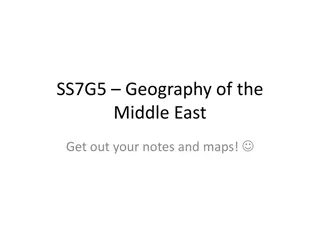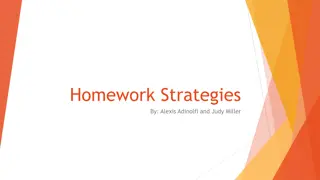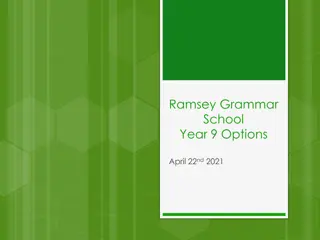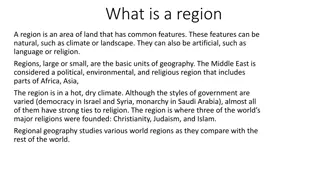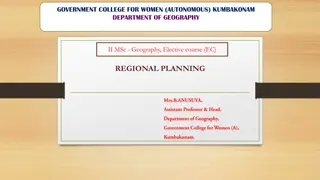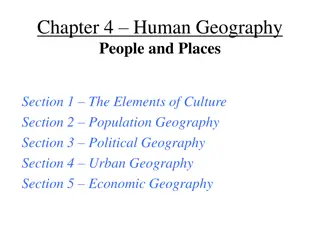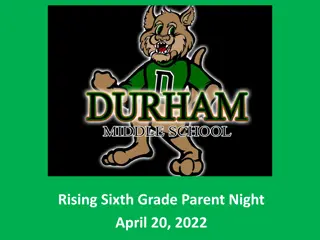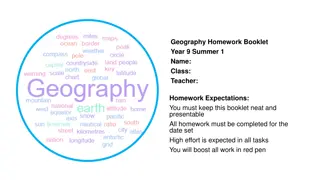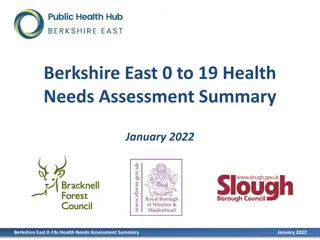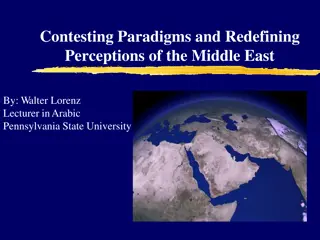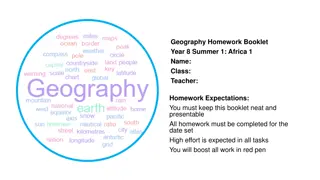Geography Homework: Exploring the Middle East in Year 8
Explore the captivating world region of the Middle East in this Year 8 geography homework booklet. From matching capitals to countries and understanding the importance of diversification, to delving into the physical geography, climate, and population changes of the region, this booklet offers a comprehensive look into the unique characteristics of the Middle East. Dive into tasks covering plate tectonics, mountain ranges, river basins, and more to enhance your knowledge of this diverse area where continents meet.
Download Presentation

Please find below an Image/Link to download the presentation.
The content on the website is provided AS IS for your information and personal use only. It may not be sold, licensed, or shared on other websites without obtaining consent from the author.If you encounter any issues during the download, it is possible that the publisher has removed the file from their server.
You are allowed to download the files provided on this website for personal or commercial use, subject to the condition that they are used lawfully. All files are the property of their respective owners.
The content on the website is provided AS IS for your information and personal use only. It may not be sold, licensed, or shared on other websites without obtaining consent from the author.
E N D
Presentation Transcript
Geography Homework Booklet Year 8 Spring: Middle East Name: Class: Teacher: Homework Expectations: You must keep this booklet neat and presentable All homework must be completed for the date set High effort is expected in all tasks You will boost all work in red pen
Year 8 Weekly Homework Spring 1.1 The Middle East: An Important World Region KB: page 32- 33 1. Match the capitals to the country: 2. Define the term Diversifying __________________________________________________________________________ CAPITAL COUNTRY __________________________________________________________________________ Cairo Saudi Arabia __________________________________________________________________________ Ankara United Arab Emirates 3. Explain why it is important for the Middle East to diversify: Doha Egypt __________________________________________________________________________ Abu Dhabi Yemen __________________________________________________________________________ Beirut Turkey __________________________________________________________________________ __________________________________________________________________________ Riyadh Qatar __________________________________________________________________________ Sana a Lebanon __________________________________________________________________________ 3. Are these statements TRUE or FALSE? 4. Fill in the key terms and definitions for the following: 1. The Middle East is where Africa, Asia and Europe meet? TRUE/ FALSE Key Term Definition 2. It is sometimes called South-East Asia? TRUE/ FALSE Crude Oil 3. Middle East describes the geography and the culture of the area? TRUE/ FALSE 4. The Middle East is home to the largest oil reserves in the world? TRUE/ FALSE An area within a country 5. The area has suffered from conflicts and unrest? TRUE/ FALSE Forced Migration 6. Its biggest natural resource is gemstones? TRUE/ FALSE Mediterranean Climate 7. The two main biomes are mountain and desert? TRUE/ FALSE
Year 8 Weekly Homework Spring 1.2 Physical Geography & Climate of the Middle East Knowledge Book Page 34-36 1. What is the difference in climate between the north and south: 2. Use the flow diagram below to show how the Middle East has been affected by plate tectonics (pg31) 2________________ _________________ _________________ North South 1________________ _________________ _________________ 3________________ _________________ _________________ 3. Explain how plate tectonics in the Middle East has formed mountains and volcanoes ____________________________________________________________________ 4. Answer the questions below: 1. What mountain ranges can be found in Tukey? ___________________________ ____________________________________________________________________ 2. What mountain ranges can be found in Iran? ____________________________________________________________________ ___________________________ ____________________________________________________________________ 3. What is found in the south of the Middle East?? ____________________________________________________________________ _______________________________________ ____________________________________________________________________ 4. There are 3 rivers basins in the Middle East, name them: ____________________________________________________________________ 1. _________________________________ ____________________________________________________________________ 2. _________________________________ 3. _________________________________
Year 8 Weekly Homework Spring 1.3 How Are Populations Changing in the Middle East? Knowledge Book: P60 1. Use P52 to fill in the key terms and definitions for the following: 3. Use compass points to describe the population distribution of the Middle East [4] Key Term Definition N The number of people living in a given area, usually within 1km A small amount of people in a given area. Densely Populated Population Distribution Old Dependent Young Dependent __________________________________________________ __________________________________________________ __________________________________________________ __________________________________________________ __________________________________________________ __________________________________________________ __________________________________________________ __________________________________________________ __________________________________________________ All the inhabitants of a particular place. 2. Draw an image/ icon for the following key terms: Old Dependent Population Sparsely Populated
Year 8 Weekly Homework Spring 1.4 Middle East Population & Economy Knowledge Book 37-38 1. Answer the following questions: 2. Complete the following statements about the Middle East: 1. It is the _______________ source of crude oil 1. Which country has the highest population? _________________________ 2. Oil was discovered in ___________ in 1908 2. Which country has the lowest population? _________________________ 3. The ____________ plate holds ____% of the worlds oil reserve 3. What country had a population of 28.3 million in 2017? _______________ 4. The discovery of oil came at the same time as the _______________ of the car. 5. The __________ and ________ became very interested in the ________ 4. How many people live in Lebanon? _____________________________ 6. Oil has brought great _______________ to some parts of the region 5. What is the population of the Middle East in total? ___________________ 7. The Middle East has been a ___________ point for trade routes for ______ years 6. Which country contains the most populated areas? __________________ 8. The region is home to three major religions: _____________, ____________ and ____________. 7. Which regions are most densely populated? ________________________ 4. Explain why Oil is important to the Middle East economy: 3. Rank the reasons for the diversity of the Middle East. E.g. It connects Asia, Africa & Europe (pg33) ____________________________________________________________________ ____________________________________________________________________ ____________________________________________________________________ ____________________________________________________________________ ____________________________________________________________________ ____________________________________________________________________ ____________________________________________________________________
Year 8 Weekly Homework Spring 1.5 Map Skills: Scale, Distance, Compass Points and Grid References Interpreting Scale: N a) 2cm on the map is what distance in real life? _______________________________ b) 3cm on the map is what distance in real life? _______________________________ c) 0.5km in real life is how many cm on the map? ____________________________ d) 4.5km in real life is how many cm on the map? ____________________________ Measuring Distance: a) On the map, how many cm apart are and ? _____________________ b) On the map, how many cm apart are and ? _____________________ c) In real life, how far apart in km are and ? _______________________ d) In real life, how far apart in km are and ? _______________________ Compass Points (Identify the correct compass direction): a) To get from to you travel ___________________________________ b) To get from to you travel ___________________________________ c) To get from to you travel ___________________________________ d) To get from to you travel ___________________________________ 6- Figure Grid References: a) What is the 6 figure grid reference for the ? ____________________________ b) Which shape is found in grid reference 238,477? ____________________________ 2cm 2cm: 4km c) Draw a in grid reference 244,467 1km
Year 8 Weekly Homework Spring 1.6 Middle East Population: UAE Vs. Yemen Knowledge Book 39-40 3a. Look at the population pyramids for UAE and Yemen. Tick the statements that are true for each location 1. Which countries population pyramid is this? Explain what it shows. _______________________ _______________________ _______________________ _______________________ _______________________ _______________________ _______________________ _______________________ _______________________ UAE Yemen High birth rate Largest population Unequal distribution of males and females A larger young dependent population Larger working population 2. Which countries population pyramid is this? Explain what it shows. 4. Wha Lower birth rate _______________________ _______________________ _______________________ _______________________ _______________________ _______________________ _______________________ _______________________ _______________________ _______________________ 3b. Explain why UAE population is so distorted and suggest what schemes/ resources the UAE government should invest in to suit it s population. __________________________________________________________________________ __________________________________________________________________________ __________________________________________________________________________ __________________________________________________________________________ __________________________________________________________________________ __________________________________________________________________________ __________________________________________________________________________
Year 8 Weekly Homework Spring 1.7 Middle East Development: Dollar Street (Access the website link on SMH) 1. Correctly define the following key terms: High Income Country (HIC) - _________________________________________________________________________________________________________________________________ Middle Income Country (MIC) - ______________________________________________________________________________________________________________________________ Newly Emerging Economy (NEE) - ____________________________________________________________________________________________________________________________ Low Income Country (LIC) -__________________________________________________________________________________________________________________________________ 2. Use the Dollar Street Website . Select any family living in either Iran, Jordan, Lebanon or Palestine, then answer the following questions about them a) Name of Family: _________________________________________________ h) How do they make a living? b) Where do they live (which country)? _________________________________ c) Monthly Income? _______________________________________________ d) Description of family (who is in the family?) i) What challenges do they face? e) Describe the bathroom/ toilet in their house f) Describe the kitchen in their house j) What do they dream of? g) Describe the bedrooms/ beds in their house .
Year 8 Weekly Homework Spring 1.8 Middle East: The Development of Yemen and the UAE Knowledge Book 39-42 1. Pick 3 ways the UAE has been able to diversity. Label them a draw an icon: 2________________ _________________ _________________ 2. Connect these words (you must make at least 4 connections): Population Government Yemen UAE 1________________ _________________ _________________ 3________________ _________________ _________________ Development Diversify 3. Match the statement to the feature of Yemen 4. Explain how the UAE has been able to develop successfully, but Yemen hasn t. ______________________________________________ ______________________________________________ ______________________________________________ ______________________________________________ ______________________________________________ ______________________________________________ ______________________________________________ ______________________________________________ ______________________________________________ ______________________________________________ Feature Statement Oil Civil War has drained its oil reserves Gender inequality They are the 7th most water stressed country in the world Infrastructure They are running out of oil Tourism 49% of women are illiterate Population They have no railways Water It has great potential but is not viable until war has ended Conflict 2/3rds of people are under 24, 60% of these are unemployed
Year 8 Weekly Homework Spring 1.9 Conflict in the Middle East Knowledge Book 43-45 1. Study P38. Fill in the figures and statistics about the conflict in Syria: 3a. P38 - Look at the 4 reasons for the conflict in Syria, rank them on the pyramid (top as the most important cause for the conflict, bottom as the least important cause) a) __________________________ people have been killed since the conflict began in 2011. b) What is the estimated economic loss suffered by Syria? ___________________________ c) There are __________________________ registered Syrian refugees. d) Average life expectancy has dropped from ____________ years to ____________years. e) _____________ Syrians live below the poverty line ($1.90 per day). f) How many people have been wounded as a result of the conflict? ___________________ g) The unemployment rate jumped from _________ to _________ between 2010 and 2014. h) What percentage of school children did not attend school today? ____________________ i) ________________________ Syrians have lost their primary source of income. 2. Use P37 and explain two factors that have caused conflict 2. Use P37 and explain two factors that have caused conflict in the Middle East: in the Middle East: One factor is ____________________________________. This has lead to conflict because ____________________________________________________________________________ ____________________________________________________________________________ 3b. Explain the order you have ranked the causes for conflict on the pyramid: ____________________________________________________________________________ ____________________________________________________________________________ ____________________________________________________________________________ ____________________________________________________________________________ Another factor is _________________________________. This has lead to conflict because ____________________________________________________________________________ ____________________________________________________________________________ ____________________________________________________________________________ ____________________________________________________________________________ ____________________________________________________________________________ ____________________________________________________________________________ ____________________________________________________________________________ ____________________________________________________________________________ ____________________________________________________________________________
Year 8 Weekly Homework Spring 2.0 Conflict in Syria: The Impacts KB: page 44-45 2a. P39 - Look at the 4 impacts of the Syrian conflict listed below, rank them on the pyramid (top as the most important impact, bottom as the least important impact) 1. Study map below to describe the distribution of Syrian refugees in the Middle East and Europe [4] 11.5% of people killed or injured 5 million refugees Refugees make dangerous journeys to Europe Children experience violence and brutality ___________________________________________________________________________ 2b. Explain the order you have ranked the impacts of conflict on the pyramid: ___________________________________________________________________________ ____________________________________________________________________________ ___________________________________________________________________________ ____________________________________________________________________________ ___________________________________________________________________________ ____________________________________________________________________________ ___________________________________________________________________________ ____________________________________________________________________________ ___________________________________________________________________________ ____________________________________________________________________________ ___________________________________________________________________________ ____________________________________________________________________________ ___________________________________________________________________________ ____________________________________________________________________________ ___________________________________________________________________________
Questions to ask: ___________________________ ___________________________ ___________________________ ___________________________ ___________________________ ___________________________ ___________________________ ___________________________ ___________________________ ___________________________ ___________________________ ___________________________ ___________________________ ___________________________ ___________________________ ___________________________ ___________________________ Notes: ___________________________ ___________________________ ___________________________ ___________________________ ___________________________ ___________________________ ___________________________ ___________________________ ___________________________ ___________________________ ___________________________ ___________________________ ___________________________ ___________________________ ___________________________ ___________________________ ___________________________
Questions to ask: ___________________________ ___________________________ ___________________________ ___________________________ ___________________________ ___________________________ ___________________________ ___________________________ ___________________________ ___________________________ ___________________________ ___________________________ ___________________________ ___________________________ ___________________________ ___________________________ ___________________________ Notes: ___________________________ ___________________________ ___________________________ ___________________________ ___________________________ ___________________________ ___________________________ ___________________________ ___________________________ ___________________________ ___________________________ ___________________________ ___________________________ ___________________________ ___________________________ ___________________________ ___________________________
Questions to ask: ___________________________ ___________________________ ___________________________ ___________________________ ___________________________ ___________________________ ___________________________ ___________________________ ___________________________ ___________________________ ___________________________ ___________________________ ___________________________ ___________________________ ___________________________ ___________________________ ___________________________ Notes: ___________________________ ___________________________ ___________________________ ___________________________ ___________________________ ___________________________ ___________________________ ___________________________ ___________________________ ___________________________ ___________________________ ___________________________ ___________________________ ___________________________ ___________________________ ___________________________ ___________________________
Questions to ask: ___________________________ ___________________________ ___________________________ ___________________________ ___________________________ ___________________________ ___________________________ ___________________________ ___________________________ ___________________________ ___________________________ ___________________________ ___________________________ ___________________________ ___________________________ ___________________________ ___________________________ Notes: ___________________________ ___________________________ ___________________________ ___________________________ ___________________________ ___________________________ ___________________________ ___________________________ ___________________________ ___________________________ ___________________________ ___________________________ ___________________________ ___________________________ ___________________________ ___________________________ ___________________________



![READ⚡[PDF]✔ Emerging Space Powers: The New Space Programs of Asia, the Middle Ea](/thumb/21554/read-pdf-emerging-space-powers-the-new-space-programs-of-asia-the-middle-ea.jpg)



